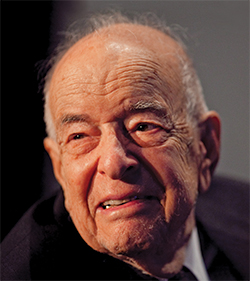Who is Herbert Tabor?
Now 99 years old, Herbert Tabor is a senior investigator at the National Institute of Diabetes and Digestive and Kidney Diseases. From 1971 to 2010, he served as editor-in-chief for the Journal of Biological Chemistry, overseeing its expansion from 1,000 to 4,500 published articles per year and its transition to online publication.
 Herbert Tabor
Herbert Tabor
Over the years, he also has authored 31 articles published in JBC, including nine co-authored with his wife, the late Celia White Tabor.
The JBC/Herbert Tabor Young Investigator Awards were conceived to honor him, said Associate Editor George DeMartino of the University of Texas Southwestern Medical Center. “And there’s probably nothing that would honor him more than having good papers published in JBC.”
Here’s a brief look at Tabor’s life and accomplishments:
| 1905: | The Journal of Biological Chemistry is founded. |
| 1918: | Herbert Tabor is born in New York City. |
| 1937: | Tabor graduates from Harvard College. |
| 1940: | Tabor meets Celia White on a streetcar in Boston. |
| 1941: | Tabor graduates with an M.D. from Harvard Medical School. |
| 1942: | Tabor starts an internship at Yale New Haven Hospital, working concurrently in the lab of John Peters. |
| 1943: | Tabor joins the war effort as medical officer on a Coast Guard cutter escorting Atlantic convoys. |
| 1943: | Tabor is transferred to the National Institutes of Health, joining Sanford Rosenthal’s team to study treatment for burns and traumatic shock. |
| 1943: | Tabor’s first article is published in JBC: Tabor and Hastings, “The ionization constant of secondary magnesium phosphate.” |
| 1946: | Herb Tabor and Celia White marry. |
| 1949: | The Tabors move into commissioned officer housing on the NIH campus, where they raise their children and where Herb Tabor still lives today. |
| 1952: | Celia White Tabor joins the Rosenthal lab, starting the Tabors’ shared research. |
| 1961: | Tabor joins the editorial board of JBC. |
| 1971: | Tabor becomes editor-in-chief of JBC. |
| 1975: | The Tabors’ first joint article is published in JBC: H. Tabor and C.W. Tabor, “Isolation, characterization and turnover of glutathionylspermidine from Escherichia coli.” |
| 1995: | JBC becomes the first scientific journal to be published online. |
| 2010: | Tabor steps down as editor-in-chief, becomes co-editor and continues his bench research. |
| 2011: | JBC Editor-in-Chief Marty Fedor announces establishment of the JBC/Herbert Tabor Young Investigator Awards to be presented by journal associate editors to presenters at specialized scientific meetings. |
| 2013: | Published in JBC 70 years after Tabor’s first JBC article: Chattopadhyay and Tabor, “Polyamines are critical for the induction of the glutamate decarboxylase dependent acid resistance system in E. coli.” |
| 2017: | JBC Editor-in-Chief Lila Gierasch announces the Tabor awards will honor work on top-notch papers published by JBC. |
Enjoy reading ASBMB Today?
Become a member to receive the print edition four times a year and the digital edition weekly.
Learn moreGet the latest from ASBMB Today
Enter your email address, and we’ll send you a weekly email with recent articles, interviews and more.
Latest in People
People highlights or most popular articles

ASBMB names 2025 fellows
Â鶹´«Ă˝É«ÇéƬ and Â鶹´«Ă˝É«ÇéƬ Biology honors 24 members for their service to the society and accomplishments in research, education, mentorship, diversity and inclusion and advocacy.

When Batman meets Poison Ivy
Jessica Desamero had learned to love science communication by the time she was challenged to explain the role of DNA secondary structure in halting cancer cell growth to an 8th-grade level audience.

The monopoly defined: Who holds the power of science communication?
“At the official competition, out of 12 presenters, only two were from R2 institutions, and the other 10 were from R1 institutions. And just two had distinguishable non-American accents.”

In memoriam: Donald A. Bryant
He was a professor emeritus at Penn State University who discovered how cyanobacteria adapt to far-red light and was a member of the Â鶹´«Ă˝É«ÇéƬ and Â鶹´«Ă˝É«ÇéƬ Biology for over 35 years.

 Yes, I have an accent — just like you
When the author, a native Polish speaker, presented her science as a grad student, she had to wrap her tongue around the English term “fluorescence cross-correlation microscopy.”

Professorships for Booker; scholarship for Entzminger
Squire Booker has been appointed to two honorary professorships at Penn State University. Inayah Entzminger received a a BestColleges scholarship to support their sixth year in the biochemistry Ph.D. program at CUNY.

